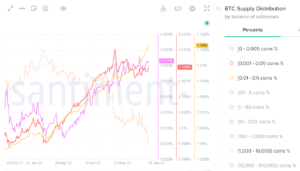Marginal Recovery

Bitcoin recovered above the psychological $20,000 last week, with the initial move higher being driven by comments by Tesla CEO Elon Musk, who came out in support of Dogecoin.
Musk told Bloomberg in an interview, “I intend to personally support Dogecoin, because I just know a lot of people who are not that wealthy who have encouraged me to buy and support Dogecoin—so I’m responding to those people.” Musk’s confidence in Doge appears to have inspired traders to move into top cryptos as well, such as BTC and ETH.
Another interesting thing from last week was growing interest among institutional investors in centralized crypto lenders like BlockFi, Voyager, and Celsius. Celsius froze customer withdrawals on June 12 and asked users to give it more time to stabilize liquidity and operations. FTX exchange extended a $250 million credit line to BlockFi and Voyager, while Goldman Sachs has expressed interest in covering Celsius’s debt. These moves by financial services giants are essentially bringing liquidity to the industry at a time of crisis, which can potentially act as a bottom signal.
However, the most prominent concerns about macroeconomic conditions and potential recession remained unchanged. In all probability, the Fed will continue to raise benchmark interest rates through the third quarter to curb inflation, creating a solid headwind for stocks and crypto.
Notably, the Chinese Communist Party also hit the wires, warning investors about the risk of Bitcoin’s price “heading to zero.” The Chinese government has been known to move the market previously, such as the exchange ban in 2017 and the mining ban in 2021. The latest warning may be a precursor to further regulations.
Lastly, BTC also faces regulatory risk due to fresh concerns about the European Union passing a new Crypto Law by June 29. The bloc’s leaders have been pushing since the start of the Ukraine war. The new law would allow EU authorities to control crypto-related businesses and possibly impose sanctions on Russian counterparts if approved.
The Fed & Miners
Concerns over the global economy will likely be a key theme as we head through the summer months. I see very little to get excited about in the near term as downside risks still prevail, even at current prices.
Moreover, the upside could be further capped over the coming weeks by the Fed’s ongoing economic policy, especially if inflation data for June comes in hot again.
Federal Reserve Chair Jerome Powell told Congress last week that the U.S. central bank must “go ahead” and keep raising interest rates to get inflation down, even if that means the economy faces higher unemployment and a potential recession.
This week’s economic growth data from the United States economy will hold the spotlight. Undoubtedly, the global economy is slowing, making it a challenging environment for the market to grow. More pessimistic data from the U.S. economy could cap the crypto market’s recent recovery.
Economic calendar for this week. Source: Forexlive
Smart Money Unhappy
The on-chain movements depict miners and mid-tier whales (BTC wallets with 1,000 to 10,000 BTC) selling heavily onto the markets, while retail investors are unfazed by the price drop. This creates a very precarious situation, as historically, the former group of stakeholders has accurately timed market cycles, and the latter has had terrible timing.
According to a report by Coinmetrics, the most active miners of 2021 sold nearly half of their holdings in June. This trend may continue as Bitcoin trades around the most efficient miners’ breakeven point, forcing miners to sell a significant portion of mined BTC to meet operation costs.
Bitcoin’s price is trading near the production cost of the most advanced mining hardware. Source: Trading View
At the same time, mid-tier whales continue to reduce their holdings, showing a lack of interest even at current prices. Miners and mid-tier whales are categorized as smart money because of their accurate market timings. Thus, their negative movement raises concerns about more weakness in the market. Lastly, with retail holdings still on the rise, I remain skeptical about a meaningful recovery in the short to medium term.
BTC Supply Distribution. Source: Santiment
BTC Skeptic
Bitcoin closed below its 200-week moving average for a second consecutive week last week. This is an adverse technical sign and one that should not be ignored as it could encourage further technical selling.
In its 12-year history, Bitcoin has tagged the 200-weekly moving average just five times. However, the last time BTC closed the week below this trendline for more than a week was in 2015. It is essential to learn about the past instances when BTC price action was similar.
A noteworthy observation is that deviations below the 200-week MA have not exceeded 30% and have been bought up quickly. A breakout and retest of the 200-weekly MA have marked the end of the bear market and the start of a new cycle. However, the current price action doesn’t seem to favor buyers.
Continued weakness below the 200-week MA makes me bearish with price targets around $16,400 and $12,400. A sustained move above the 200-week MA could see BTC taggin $27,000.
BTC/USD Daily price chart. Source: Trading View
ETH Rebound
Not betting on the downtrend in Ethereum has been a costly error this year, and given that very little has changed in terms of fundamentals, I think going against the trend path is still risky.
Short-term rebounds are very typical for ETH. However, calling a market bottom is still very hard given that Bitcoin, which traditionally holds a strong correlation with ETH, may or may not have bottomed yet.
With this in mind, we probably need to see ETH/USD moving back above the $1,500 level before confirming a market bottom. The $1,300 level is a big challenge this week. Failure to move above this area and ETH/USD could quickly revisit the $1,100 or $1,000 level.
ETH/USD Daily price chart. Source: Trading View
Market Cap Clues
The Crypto Total Market Capitalization chart across the lower time frames presents a glimmer of hope for the latest recovery with a bullish inverted head and shoulders pattern.
However, the price plunge under the $850 billion level should probably have held on the first attempt, and it troubles me quite considerably that the market can break such a significant technical area that easily.
The crypto market cap has always been drawn to big numbers. Logic would dictate that we would probably see buyers testing back to the psychologically important $1 trillion resistance level at some point.
This could hint that the market will launch a wider recovery over the coming week. My main concern is a much deeper drop towards the $500 billion zone if the market capitalize on the recovery, falling back under $850 billion.
Crypto Total Market Capitalization H4 price chart. Source: Trading View
The Bottom Line
Given that the macroeconomic risk factors remain unchanged, and we are still seeing record amounts of divergence between smart wallets and retail holdings, I think it is still too premature to call a market bottom.
It is far more likely that the current rally will likely encounter selling pressure around the 200-weekly moving average. Even if buyers can push the price above this level, I would remain cautious of long-term resistance at $27,000 before placing large bets.







